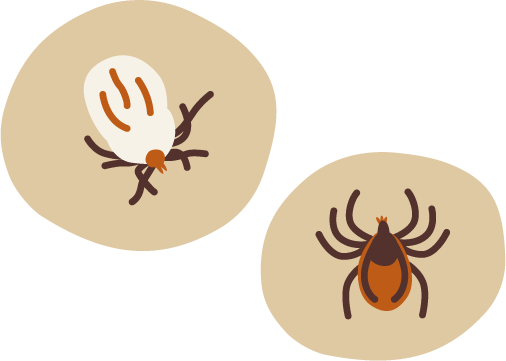Tick and Flea Treatments = Rocks and Hard Places

Ticks and fleas are a real problem. They suck your pet’s blood - with heavy infestations, this can cause anaemia, and in rare cases, even death (has to be a ridiculously high burden for this to happen). The bites cause irritation, and if animals develop an allergy to the bites, that can cause severe itching, chewing all of their hair off, and a lot of suffering.
Here in Australia (and in some areas of the USA) we have paralysis ticks. These are very nasty, the toxin they excrete when they are feeding on your pet causes paralysis, and this kills many pets. It’s a serious risk!
Ticks and fleas may also carry and infect your pets with a range of diseases, and some of them are pretty nasty. Let’s take a look at the diseases each carry in detail.

Tick and Flea Borne Diseases in Pets
Ticks carry a range of bacteria in their stomach. When the tick is feeding on your pet, the bacteria may be transmitted into your pet’s blood stream, causing infection. Here’s a list of the diseases + symptoms.
Lyme Disease: Spirochaete intracellular bacteria: Borrelia burgdorferi - primarily transmitted by Ixodes (paralysis ticks here in Australia). Causes lameness, fever, reduced appetite, lethargy, kidney failure.
Ehrlichiosis: Intracellular bacteria, Ehrlichia ewingii and E. Canis - primarily transmitted by Lone Star (USA) and brown dog tick bites. Causes haemorrhage (bleeding), fever, lethargy, decreased appetite, lameness. Ehrlichiosis has recently moved into the NorthWest of Australia, is spreading, and will become a serious problem everywhere there are brown dog ticks in time. It's a serious illness and kills dogs.
Rocky Mountain Spotted Fever: Intracellular bacteria Rickettsia rickettsii - transmitted by ixodes tick species here in Australia. Causes fever, weight loss, lethargy, lameness.
Anaplasmosis: intracellular bacteria Anaplasma phagocytophilum - Primarily transmitted by Ixodes tick bites. Causes lethargy, lack of appetite, fever, dehydration.
Tularemia: Intracellular bacteria Francisella tularensis - transmitted by tick bites, deer fly bites, or contact with infected animals (possums) or contaminated water. Very rare in Australia, only 4 cases ever confirmed.
These are all bacterial diseases, and all of these bacteria live inside your pet’s cells. This makes them hard to detect, and hard to treat. Antibiotic treatment is the conventional choice (that’s if you can actually get a confirmed diagnosis) - heavy, long courses, that often don’t cure the disease.
These intracellular parasitic bacteria tend to hijack your dog's immune system and cause inflammation to help them hide from the immune response. They also devour your pet’s energy and nutrients from inside the cells. These diseases may all cause (or be an important factor in) chronic disease of many kinds in our pets.
It’s important to freeze ticks (tick spray, wart spray) to kill them before you remove them from your dogs (and from yourself). If you pull them off while still alive, they often regurgitate their stomach contents (and a lot of bacteria) into the bloodstream. Killing the ticks by freezing them before pulling them off significantly reduces the chances of infection.
Babesiosis: Protozoan (intracellular parasite) Hemoprotozoans babesia primarily transmitted by ixodes ticks (and some other tick species). Causes weakness, bleeding issues, fever
Hepatozoonosis: Protozoan (intracellular parasite) Hepatozoon americanum and H. Canis - Causes decreased appetite, fever, lethargy, dehydration. Incredibly rare in Australia.
Flea Borne Disease in Pets

Bartonella: Also known as ‘Cat Scratch Fever’ (many vets are infected with this) intracellular bacteria of Bartonella species - different species transmitted by fleas (cat scratches are infective in carrying infected fleas, as the claws are contaminated with flea faeces), may also be transmitted by body lice and sand flies. Causes fever, weight loss, decreased appetite, coughing, lameness, weakness.
Rickettsia: Some Rickettsia species are also transmitted by fleas - Tick Typhus, Rocky Mountain Spotted fever.
Yersiniosis: Plague! Bubonic Plague and the Black Death are transmitted by the Oriental rat flea. This is a very rare disease, however.
Mycoplasma Infection: Cats may be infected with some kinds of mycoplasma transmitted by fleas which can cause anaemia. A range of mycoplasma diseases are also transmitted by ticks.

Risk Benefit Analysis! (Or: Is the Cure Worse Than the Problem?)
We need to be clear about the risks from ticks and fleas. And we need to understand the risks that come with the preventative poisons that we administer to our pets. Because let’s be clear, they are poisons. Insecticides. And these chemicals are toxic. The majority of pets will cope with them ok, but some animals who are more sensitive will have adverse reactions. They will be poisoned, and this can range from mild, transient unwellness, right through to severe illness, triggering epilepsy, gastro-intestinal symptoms, neurological problems, never the same again, right up to and including death in some cases.
Let's talk about the insecticides used in tick and flea prevention for our pets. I’ll start with the newest ones, and then move to the older ones.
Isoxazolines: You’ll find these in Nexgard, Bravecto, Simparica, Credelio and Revolution Plus. These have a long residual, and you’ll find spot on (topical) and oral tablets/chews. They prevent fleas and ticks. However, the tick or flea must bite your pet, so there is still some risk of infection as above.
I would not use these in my own pets unless the risk was extremely high, and even then, I’d think twice. I believe the risk of harm is significant.
Spinosad: The active ingredient in the monthly flea prevention Comfortis. I believe this is safer than the Isoxazolines, but there still is risk, animals have been injured by this one too. I use this for my pets if they get a flea infestation. This still works pretty well; fleas are starting to develop some resistance.
Imidacloprid + Permethrin: a topical that controls fleas, ticks, mosquitoes, sand flies, lice and stable flies. Advantix is probably the most common one using these.Also revolution, which I find pretty ineffective these days. Again, not risk free. May cause neurological issues. I believe there’s a fair bit of flea resistance to Imadocoprid.
Fipronil: this is the active ingredient in Frontline spot ons and spray. I find that resistance to this in fleas is very high these days. Does not control ticks. Rarely causes neurological side effects.
Then you get into old school ones - organophosphate compounds (e.g. kiltix collars - I used these when I was living in paralysis tick areas. Works pretty well, if there is a toxic effect, we have an antidote, but no good for dogs that swim or get wet). And Nitenpyram (Capstar) - this is short acting, kills all fleas very quickly, only 12-24 hours residual.
Then you have a whole host of Pyrethrum and other chemicals which are short acting, and often not terribly effective - you should actively avoid all the flea/tick products and collars in the supermarket. Most of them simply don’t work very well, if at all. Any flea shampoos will only kill the fleas on the dog. And only about 5% of fleas will be on your pets at any time.
There are also some very poisonous dips and chemicals designed for use in farming. Please don’t use them. They are often very strong organophosphates, and pretty risky.

Natural Tick/Flea Control Options
I’m sorry to tell you this, but the natural preventatives are often pretty ineffective. If you get a flea infestation in your home, you can cure it with a LOT of work- washing everything again and again, vacuuming your whole house daily, steam cleaning your carpets to kill flea eggs, diatomaceous earth, perhaps using essential oils as a repellent, ultrasonic tags for ticks, resonant tags to help repel ticks and fleas, weekly flea baths. Neem oil is a natural insecticide, it can cause toxicity problems at higher doses, so care is required.
Apple cider vinegar can help - internally + externally. Amber collars may have some effect. Nutrition can help the more healthy and vital your pets are, the less likely they are to get fleas and ticks. B vitamins, probiotics, sulfur rich foods like eggs, cahhabe, broccoli, cauliflower, and essential fatty acids may help.
One very effective natural treatment for prevention (and controlling outbreaks with a stronger dose are flea nematodes. These are microscopic worms that live in the soil and eat flea eggs. You can find and order them online, then spray them all over your yard.
With severe infestations of fleas, you may have to resort to the riskier chemicals. If you live in a paralysis tick area, likewise. The majority of pets will cope with these chemicals, there is real risk of harm for pets more sensitive to the compounds. Rocks and hard places everywhere, you have to make the best-informed decision you can.
When I lived where there were paralysis ticks, I used kiltix collars (be aware they won’t work well for a week or two after a bath) and daily, careful, all-over checks. This approach does not prevent your dogs contracting diseases like ehrlichiosis. The regular veterinary recommendations to prevent ehrlichiosis are to treat your dog with a preventative that kills ticks, and another that repels them - like Bravecto to kill them and a Seresto collar to repel. A double dose and hence more risk for your pets. There are simply no easy answers…
About the Author - Dr Edward Bassingthwaighte.

Dr Edward Bassingthwaighte is a holistic veterinarian, and a world-leading expert in silent pain in pets. Dr Edward is passionate about fresh raw whole foods for dogs. He is the founder of the Whole Energy Body Balance method- a profoundly healing bodywork modality for pet parents and pet wellness professionals to relieve silent pain, anxiety and trauma in pets. Join Dr Edward's free masterclass on silent pain in pets here.
If you liked this article, sign up to our Big Dog Fam Mail to receive more great pet health and happiness advice.
If you liked this article, please share on Facebook.
